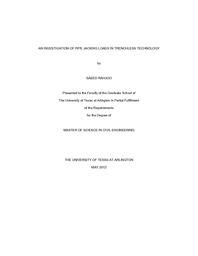
ATTENTION: The works hosted here are being migrated to a new repository that will consolidate resources, improve discoverability, and better show UTA's research impact on the global community. We will update authors as the migration progresses. Please see MavMatrix for more information.
Show simple item record
| dc.contributor.author | Rahjoo, Saeed | en_US |
| dc.date.accessioned | 2012-07-25T19:22:55Z | |
| dc.date.available | 2012-07-25T19:22:55Z | |
| dc.date.issued | 2012-07-25 | |
| dc.date.submitted | January 2012 | en_US |
| dc.identifier.other | DISS-11566 | en_US |
| dc.identifier.uri | http://hdl.handle.net/10106/11157 | |
| dc.description.abstract | Pipe jacking is a trenchless technology method of installing pipes under existing facilities such as roads and railroads. Predicting jacking forces is important for planning, design, and construction phases of these projects. The jacking forces dictate shaft or pit locations, thrust block or backstop design, jacking equipment, use of intermediate jacking stations, and pipe bearing capacity. Calculating jacking forces depends on several site and project parameters such as soil and site conditions, lubrication, size of overcut, and steering corrections. Excessive jacking forces can damage the pipe and destabilize the drive shaft, which may stop project progress. There are different methods of calculating jacking loads presented by researchers and industry organizations. By using different models, a high discrepancy can be observed in results creating unreliability when precise calculation is required. Even though these methods are supported by numerous valid experimental tests and recorded values based on real projects, the source of created resistant force is not certain and more research is required in this field. To cover the unknown, some methods introduce higher bound limit. For example, ASCE 27 recommends using experimental values to calculate frictional forces and do not consider the face pressure. Other researchers have considered detailed analysis of soil conditions at the face, recommend including project specific conditions such as pipe depth, and bore stability. This research presents an analysis of literature on estimating loads in pipe jacking operations and compares recorded data from pipe jacking projects with a series of selected jacking force prediction models. The results compare reliability of different prediction models to accurately estimate jacking loads. | en_US |
| dc.description.sponsorship | Najafi, Mohammad | en_US |
| dc.language.iso | en | en_US |
| dc.publisher | Civil & Environmental Engineering | en_US |
| dc.title | An Investigation Of Pipe Jacking Loads In Trenchless Technology | en_US |
| dc.type | M.S. | en_US |
| dc.contributor.committeeChair | Najafi, Mohammad | en_US |
| dc.degree.department | Civil & Environmental Engineering | en_US |
| dc.degree.discipline | Civil & Environmental Engineering | en_US |
| dc.degree.grantor | University of Texas at Arlington | en_US |
| dc.degree.level | masters | en_US |
| dc.degree.name | M.S. | en_US |
Files in this item
- Name:
- Rahjoo_uta_2502M_11566.pdf
- Size:
- 17.33Mb
- Format:
- PDF
This item appears in the following Collection(s)
Show simple item record


